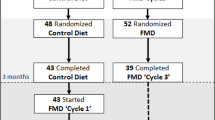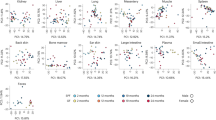Abstract
Background
A high intake of linoleic acid (LA), the major dietary polyunsaturated fatty acid (PUFA), has previously been associated with reduced cardiovascular (CV) morbidity and mortality in observational studies. However, recent secondary analyses from clinical trials of LA-rich diet suggest harmful effects of LA on CV health.
Methods
A total of 3706 participants, all born in 1950, were included in this cross-sectional study. We investigated associations between plasma phospholipid levels of LA and CV risk factors in a Norwegian general population, characterized by a relative low LA and high marine n-3 PUFA intake. The main statistical approach was multivariable linear regression.
Results
Plasma phospholipid LA levels ranged from 11.4 to 32.0 wt%, with a median level of 20.8 wt% (interquartile range 16.8–24.8 wt%). High plasma LA levels were associated with lower serum low-density lipoprotein cholesterol levels (standardized regression coefficient [Std. β-coeff.] −0.04, p = 0.02), serum triglycerides (Std. β-coeff. −0.10, p < 0.001), fasting plasma glucose (Std. β-coeff. −0.10, p < 0.001), body mass index (Std. β-coeff. −0.13, p < 0.001), systolic and diastolic blood pressure (Std. β-coeff. −0.04, p = 0.03 and Std. β-coeff. −0.02, p = 0.02, respectively) and estimated glomerular filtration rate (Std. β-coeff. −0.09, p < 0.001). We found no association between plasma LA levels and high-density lipoprotein cholesterol levels, glycated hemoglobin, carotid intima-media thickness, or C-reactive protein.
Conclusion
High plasma LA levels were favorably associated with several CV risk factors in this study of a Norwegian general population.
This is a preview of subscription content, access via your institution
Access options
Subscribe to this journal
Receive 12 print issues and online access
$259.00 per year
only $21.58 per issue
Buy this article
- Purchase on Springer Link
- Instant access to full article PDF
Prices may be subject to local taxes which are calculated during checkout


Similar content being viewed by others
References
Whelan J, Fritsche K. Linoleic acid. Adv Nutr. 2013;4:311–2.
Farvid MS, Ding M, Pan A, Sun Q, Chiuve SE, Steffen LM, et al. Dietary linoleic acid and risk of coronary heart disease: a systematic review and meta-analysis of prospective cohort studies. Circulation. 2014;130:1568–78.
Wu JH, Lemaitre RN, King IB, Song X, Psaty BM, Siscovick DS, et al. Circulating omega-6 polyunsaturated fatty acids and total and cause-specific mortality: the Cardiovascular Health Study. Circulation. 2014;130:1245–53.
Marklund M, Wu JHY, Imamura F, Del Gobbo LC, Fretts A, de Goede J, et al. Biomarkers of dietary omega-6 fatty acids and incident cardiovascular disease and mortality. Circulation. 2019;139:2422–36.
Ramsden CE, Zamora D, Leelarthaepin B, Majchrzak-Hong SF, Faurot KR, Suchindran CM, et al. Use of dietary linoleic acid for secondary prevention of coronary heart disease and death: evaluation of recovered data from the Sydney Diet Heart Study and updated meta-analysis. BMJ. 2013;346:e8707.
Ramsden CE, Zamora D, Majchrzak-Hong S, Faurot KR, Broste SK, Frantz RP, et al. Re-evaluation of the traditional diet-heart hypothesis: analysis of recovered data from Minnesota Coronary Experiment (1968-73). BMJ. 2016;353:i1246.
Fritsche KL. The science of fatty acids and inflammation. Adv Nutr. 2015;6:293S–301S.
Harris WS, Mozaffarian D, Rimm E, Kris-Etherton P, Rudel LL, Appel LJ, et al. Omega-6 fatty acids and risk for cardiovascular disease: a science advisory from the American Heart Association Nutrition Subcommittee of the Council on Nutrition, Physical Activity, and Metabolism; Council on Cardiovascular Nursing; and Council on Epidemiology and Prevention. Circulation. 2009;119:902–7.
Legrand P, Morise A, Kalonji E. Update of French nutritional recommendations for fatty acids. World Rev Nutr Diet. 2011;102:137–43.
EFSA. Labelling reference intake values for n-3 and n-6 polyunsaturated fatty acids. EFSA J. 2009;1176:1–11.
Sioen I, van Lieshout L, Eilander A, Fleith M, Lohner S, Szommer A, et al. Systematic review on n-3 and n-6 polyunsaturated fatty acid intake in european countries in light of the current recommendations—focus on specific population groups. Ann Nutr Metab. 2017;70:39–50.
Engeset D, Alsaker E, Ciampi A, Lund E. Dietary patterns and lifestyle factors in the Norwegian EPIC cohort: the Norwegian Women and Cancer (NOWAC) study. Eur J Clin Nutr. 2005;59:675–84.
Nordic Council of Ministers. Nordic nutrition recommendations 2012. 2014;5:1. https://doi.org/10.6027/Nord2014-002.
Hodson L, Skeaff CM, Fielding BA. Fatty acid composition of adipose tissue and blood in humans and its use as a biomarker of dietary intake. Prog Lipid Res. 2008;47:348–80.
Hodge AM, Simpson JA, Gibson RA, Sinclair AJ, Makrides M, O’Dea K, et al. Plasma phospholipid fatty acid composition as a biomarker of habitual dietary fat intake in an ethnically diverse cohort. Nutr Metab Cardiovasc Dis. 2007;17:415–26.
Berge T, Vigen T, Pervez MO, Ihle-Hansen H, Lyngbakken MN, Omland T, et al. Heart and brain interactions—the Akershus Cardiac Examination (ACE) 1950 Study Design. Scand Cardiovasc J. 2015;49:308–15.
Obesity: preventing and managing the global epidemic. Report of a WHO consultation. World Health Organ Tech Rep Ser. 2000;894:1–253.
Expert Panel on Detection Evaluation, Treatment of High Blood Cholesterol in Adults. Executive summary of the third report of The National Cholesterol Education Program (NCEP) Expert Panel on Detection, Evaluation, and Treatment of High Blood Cholesterol in Adults (Adult Treatment Panel III). JAMA. 2001;285:2486–97.
Levey AS, Stevens LA, Schmid CH, Zhang YL, Castro AF 3rd, Feldman HI, et al. A new equation to estimate glomerular filtration rate. Ann Intern Med. 2009;150:604–12.
Ihle-Hansen H, Vigen T, Ihle-Hansen H, Ronning OM, Berge T, Thommessen B, et al. Prevalence of carotid plaque in a 63- to 65-year-old Norwegian cohort from the general population: the ACE (Akershus Cardiac Examination) 1950 Study. J Am Heart Assoc. 2018;7.
Folch J, Lees M, Sloane Stanley GH. A simple method for the isolation and purification of total lipides from animal tissues. J Biol Chem. 1957;226:497–509.
Burdge GC, Wright P, Jones AE, Wootton SA. A method for separation of phosphatidylcholine, triacylglycerol, non-esterified fatty acids and cholesterol esters from plasma by solid-phase extraction. Br J Nutr. 2000;84:781–7.
Wu JHY, Marklund M, Imamura F, Tintle N, Ardisson Korat AV, de Goede J, et al. Omega-6 fatty acid biomarkers and incident type 2 diabetes: pooled analysis of individual-level data for 39 740 adults from 20 prospective cohort studies. Lancet Diabetes Endocrinol. 2017;5:965–74.
Cabout M, Alssema M, Nijpels G, Stehouwer CDA, Zock PL, Brouwer IA, et al. Circulating linoleic acid and alpha-linolenic acid and glucose metabolism: the Hoorn Study. Eur J Nutr. 2017;56:2171–80.
Imamura F, Micha R, Wu JH, de Oliveira Otto MC, Otite FO, Abioye AI, et al. Effects of saturated fat, polyunsaturated fat, monounsaturated fat, and carbohydrate on glucose-insulin homeostasis: a systematic review and meta-analysis of randomised controlled feeding trials. PLoS Med. 2016;13:e1002087.
Knottnerus SJG, Bleeker JC, RCI Wust, Ferdinandusse SLIJ, Wijburg FA, et al. Disorders of mitochondrial long-chain fatty acid oxidation and the carnitine shuttle. Rev Endocr Metab Disord. 2018;19:93–106.
Liu X, Li Y, Tobias DK, Wang DD, Manson JE, Willett WC, et al. Changes in types of dietary fats influence long-term weight change in US women and men. J Nutr. 2018;148:1821–9.
Nakamura MT, Nara TY. Structure, function, and dietary regulation of delta6, delta5, and delta9 desaturases. Annu Rev Nutr. 2004;24:345–76.
Warensjö E, Risérus U, Vessby B. Fatty acid composition of serum lipids predicts the development of the metabolic syndrome in men. Diabetologia. 2005;48:1999–2005.
Vessby B, Gustafsson IB, Tengblad S, Boberg M, Andersson A. Desaturation and elongation of Fatty acids and insulin action. Ann NY Acad Sci. 2002;967:183–95.
Hussein N, Ah-Sing E, Wilkinson P, Leach C, Griffin BA, Millward DJ. Long-chain conversion of [13C]linoleic acid and alpha-linolenic acid in response to marked changes in their dietary intake in men. J Lipid Res. 2005;46:269–80.
Rett BS, Whelan J. Increasing dietary linoleic acid does not increase tissue arachidonic acid content in adults consuming Western-type diets: a systematic review. Nutr Metab. 2011;8:36.
Johnson GH, Fritsche K. Effect of dietary linoleic acid on markers of inflammation in healthy persons: a systematic review of randomized controlled trials. J Acad Nutr Diet. 2012;112:1029–41. 41 e1-15
Kelley-Hedgepeth A, Lloyd-Jones DM, Colvin A, Matthews KA, Johnston J, Sowers MR, et al. Ethnic differences in C-reactive protein concentrations. Clin Chem. 2008;54:1027–37.
Brenna JT. Efficiency of conversion of alpha-linolenic acid to long chain n-3 fatty acids in man. Curr Opin Clin Nutr Metab Care. 2002;5:127–32.
Mensink RP, Zock PL, Kester AD, Katan MB. Effects of dietary fatty acids and carbohydrates on the ratio of serum total to HDL cholesterol and on serum lipids and apolipoproteins: a meta-analysis of 60 controlled trials. Am J Clin Nutr. 2003;77:1146–55.
Drouin-Chartier JP, Tremblay AJ, Lepine MC, Lemelin V, Lamarche B, Couture P. Substitution of dietary omega-6 polyunsaturated fatty acids for saturated fatty acids decreases LDL apolipoprotein B-100 production rate in men with dyslipidemia associated with insulin resistance: a randomized controlled trial. Am J Clin Nutr. 2018;107:26–34.
van Schalkwijk DB, Pasman WJ, Hendriks HF, Verheij ER, Rubingh CM, van Bochove K, et al. Dietary medium chain fatty acid supplementation leads to reduced VLDL lipolysis and uptake rates in comparison to linoleic acid supplementation. PLoS ONE. 2014;9:e100376.
Al-Khudairy L, Hartley L, Clar C, Flowers N, Hooper L, Rees K. Omega 6 fatty acids for the primary prevention of cardiovascular disease. Cochrane Database Syst Rev. 2015:CD011094.
Polak JF, O’Leary DH. Carotid intima-media thickness as surrogate for and predictor of CVD. Glob. Heart. 2016;11:295–312 e3.
Sala-Vila A, Cofan M, Perez-Heras A, Nunez I, Gilabert R, Junyent M, et al. Fatty acids in serum phospholipids and carotid intima-media thickness in Spanish subjects with primary dyslipidemia. Am J Clin Nutr. 2010;92:186–93.
Ren L, Cai J, Liang J, Li W, Sun Z. Impact of cardiovascular risk factors on carotid intima-media thickness and degree of severity: a cross-sectional study. PLoS ONE. 2015;10:e0144182.
Touboul PJ, Labreuche J, Bruckert E, Schargrodsky H, Prati P, Tosetto A, et al. HDL-C, triglycerides and carotid IMT: a meta-analysis of 21,000 patients with automated edge detection IMT measurement. Atherosclerosis. 2014;232:65–71.
Lauretani F, Semba RD, Bandinelli S, Miller ER 3rd, Ruggiero C, Cherubini A, et al. Plasma polyunsaturated fatty acids and the decline of renal function. Clin Chem. 2008;54:475–81.
Pertiwi K, Wanders AJ, Harbers MC, Küpers LK, Soedamah-Muthu SS, de Goede J, et al. Plasma and dietary linoleic acid and 3-year risk of type 2 diabetes after myocardial infarction: a prospective analysis in the alpha omega cohort. Diabetes Care. 2020;43:358–65.
Pertiwi K, Kok DE, Wanders AJ, de Goede J, Zock PL, Geleijnse JM. Circulating n-3 fatty acids and linoleic acid as indicators of dietary fatty acid intake in post-myocardial infarction patients. Nutr Metab Cardiovasc Dis. 2019;29:343–50.
Acknowledgements
We acknowledge the skilled study staff at the Clinical Trial Unit, Division of Medicine, Akershus University Hospital, and the Department of Medical Research, Bærum Hospital, Vestre Viken Hospital Trust. We also thank the staff at The Lipid Research Laboratory, Aalborg University Hospital, Denmark, who performed the fatty acid analyses. Finally, we would like to thank the study participants.
Funding
The ACE (Akershus Cardiac Examination) 1950 Study is funded by two health trusts (Akershus University Hospital HF and Vestre Viken HF), and the South-Eastern Norway Regional Health Authority, the University of Oslo, and the Norwegian Health Association. AC was supported by public funding grants from Akershus University Hospital.
Author information
Authors and Affiliations
Contributions
AC, IAE, and MS designed the present study. HR, TO, MNL, TB, and AT designed and organized the ACE 1950 Study including baseline examinations and data collection. TV, HI-H, EBO, and OMR performed carotid ultrasound and baseline examinations. EBS was responsible for the fatty acid analyses. AC, IAE, and SN analyzed the data. AC, IAE, and MS edited the paper, EBS, TO, HR, TV, HI-H, SN, EBO, OMR, MNL, TB, and AT co-edited the paper. All the authors approved the final version of the paper. AC submitted the paper.
Corresponding author
Ethics declarations
Conflict of interest
The authors declare that they have no conflict of interest.
Additional information
Publisher’s note Springer Nature remains neutral with regard to jurisdictional claims in published maps and institutional affiliations.
Supplementary information
Rights and permissions
About this article
Cite this article
Chandra, A., Røsjø, H., Svensson, M. et al. Plasma linoleic acid levels and cardiovascular risk factors: results from the Norwegian ACE 1950 Study. Eur J Clin Nutr 74, 1707–1717 (2020). https://doi.org/10.1038/s41430-020-0641-4
Received:
Revised:
Accepted:
Published:
Issue Date:
DOI: https://doi.org/10.1038/s41430-020-0641-4



